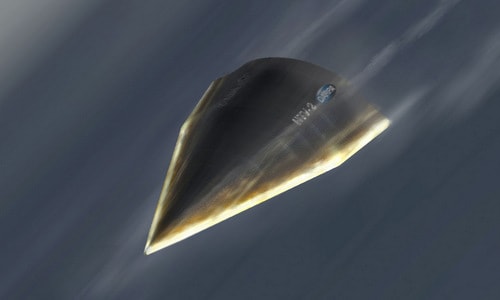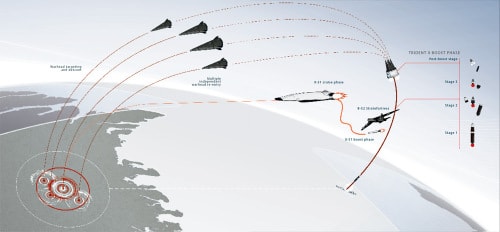US Navy tests Prompt Global Strike weapon for first time
The hypersonic weapon tested by the US Navy is said to be powerful enough to attack any target on Earth within an hour.
 |
Hypersonic warhead design in PGS project. Illustration photo: DARPA |
The US Navy said on November 7 that it had tested a hypersonic weapon system in Prompt Global Strike (PGS) last weekend. This is a weapon technology that allows Washington to attack anywhere on Earth within an hour, minimizing the enemy's ability to detect and counter, Popular Mechanic reported.
The US began to look into ultra-long-range precision-guided weapons in 2001, when the George W. Bush administration wanted to put a non-nuclear warhead on a ballistic missile or a super-fast cruise missile. This way, the US could strike any target in a short time, when other strategic weapons such as aircraft carriers and bombers could not react.
The PGS concept was developed strongly after the terrorist attacks of September 11, 2001. They are considered an effective weapon to attack targets that appear in a short time and are difficult to detect, such as terrorist meetings. In fact, the US used this method to attack the residence of former Iraqi president Saddam Hussein before the military campaign in 2003, but Mr. Hussein was not present at that location.
US military officials believe PGS could be used to destroy nuclear missiles on launch pads in North Korea or Iran, attack weapons of mass destruction in the hands of terrorist groups, or even launch a lightning preemptive strike in the event of a conflict with China or Russia.
Initially, the US deployed a variety of weapons in PGS, including a conventional warhead variant of the Trident D-5 submarine-launched ballistic missile. However,opponents possessing nuclear weapons are veryIt would be difficult to distinguish whether the Trident D-5 missile that was just launched was a nuclear-capable variant or not. This could force them to trigger a devastating retaliatory strike.
 |
The operating mechanism of a Trident missile carrying a conventional warhead. Photo: DARPA. |
The US Navy is testing hypersonic weapons technology that can travel at speeds of 6,175-12,350 km/h, 5-10 times faster than the speed of sound. The warhead is mounted on a ballistic missile, which will gain altitude and speed before separating from the warhead, allowing it to accelerate and glide towards its target. Hypersonic weapons have a different trajectory than ballistic missiles, making them easier to distinguish on radar screens.
Last weekend’s test was the first time the US Navy had tested a missile under the PGS program. Submarines are the ideal platform for this lightning strike, as they can hide close to the target, shortening the reaction time for a preemptive strike.
However, Washington is still facing difficulties in developing hypersonic weapons, as they become very difficult to control and lose accuracy as speed increases. The temperature of the warhead shell can reach nearly 1,000 degrees Celsius at maximum speed, requiring the use of advanced technology and materials. These are major technological challenges, but not necessarily insurmountable.
The US is not the only country working on hypersonic weapons. China has tested a weapon codenamed DF-ZF, while Russia has also developed a hypersonic glide weapon, the Yu-71, with similar capabilities.
According to VNE
| RELATED NEWS |
|---|








